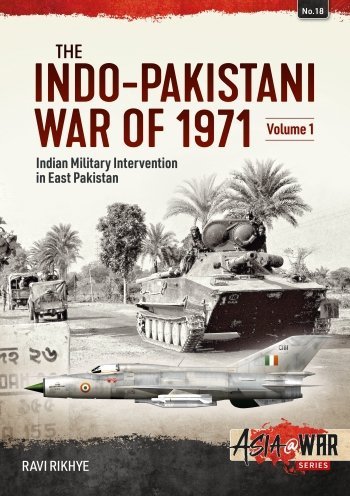-
Załączniki bezpieczeństwa
Załczniki do produktuZałączniki dotyczące bezpieczeństwa produktu zawierają informacje o opakowaniu produktu i mogą dostarczać kluczowych informacji dotyczących bezpieczeństwa konkretnego produktu
-
Informacje o producencie
Informacje o producencieInformacje dotyczące produktu obejmują adres i powiązane dane producenta produktu.HELION
-
Osoba odpowiedzialna w UE
Osoba odpowiedzialna w UEPodmiot gospodarczy z siedzibą w UE zapewniający zgodność produktu z wymaganymi przepisami.
Indian Military Intervention in East Pakistan
Series : Asia@War #18
Author : Ravi Rikhye
General - Pages : 84 | Images : 89 b/w photos, 1 colour & 5 b/w maps, 20 colour profiles, 4 colour figures, 18 tables
Paperback - Date of Publication : December 2020 | Size : 297mm x 210mm | ISBN : 9781913118631 | Helion Book Code : HEL1190
In 1947, India and Pakistan were partitioned by their former colonial ruler, Great Britain. A job that should have taken ten-years was done in a few months. Britain, drained by two world wars in 40 years, no longer had the will or the money to guide the subcontinent to a peaceful partition by consensus. More importantly, the subcontinent was impatient for Britain’s departure. The British left in haste, leaving unresolved the issue of Kashmir and as a festering sore between the two states. This triggered five wars between the new states: 1947-48, 1965, 1971, 1999 and continuing insurgency/counterinsurgency that began in 1987. Two other potential wars were narrowly averted in 1987-88 and 2001-02, and a limited one fought in 1999. Since the basic issue remains unresolved, the next war may be only a matter of time.
Pakistan itself was composed of two geographically separated portions, the East and the West, with little in common other than the Muslim religion. In 1970, East Pakistan voted for independence; armed rebellion soon followed, and a vicious counterinsurgency attempted to suppress the rebellion. India, seizing the chance to change the balance of power, militarily supported the East Pakistan insurgency. With Indian troops on the ground from November 1971 they openly invaded East Pakistan in early December with eight divisions. Pakistan launched air attacks against India in the west and an all-out war resulted. East Pakistan was overrun by India by 16 December; the US and Soviet forced a ceasefi re in the West only a day later. For the first time in 800 years, a predominantly Hindu army had defeated a Muslim army.
The first volume of The Indo-Pakistani War of 1971 mini-series, Indian Military Intervention in East Pakistan, tells the captivating story of the military conflict fought between India and Pakistan in 1971 in what is present day Bangladesh, and resulted in the emergence of Bangladesh as an independent nation. This book makes extensive use of offi cial records and participant recollections, rare photography and original colour artworks.
"The author has put forth a lot of effort to research this war, a job made easier by the release of a lot of documents from 50 years ago and made more difficult by an inability to see some archival material. Nevertheless, it provides a fairly complete look at this part of the war and provides us with insights not shown in some other publications of the period. Well worth picking up as it is a great read and is a book I very much recommend to you." ModellingMadness.com
"Rikhye does a masterful job of encapsulating the causes and strategic overview of the war." The Historical Miniatures Gaming Society
".........an excellent, easily readable resource for those interested in this complex post-colonial conflict. It provides valuable reference material for the modeler interested in modern armor, figures, or aircraft. This work whets one's appetite for more accounts of these poorly understood regional wars in modern Asia." IPMS/USA
"Complemented by some useful maps and colour artwork, this is a useful account that will be helpful to students of modern warfare and the evolution of the post-colonial world." Flypast Magazine
"A detailed account, using what official records there are, and involving politics, military force, religion and the outside influences on each sides." Military Model Scene
"The lavishly illustrated effort sports dozens of photos. Twenty-two excellent color plates – military vehicles by David Bocquelet, uniforms by Anderson Subtil, and aircraft by Tom Cooper – provide potent project potential. And maps put campaign commentary into geographic perspective." Cybermodeler










